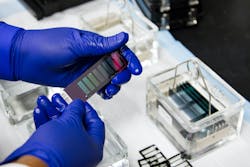Researchers from the National Cancer Institute’s (NCI) Center for Cancer Research, part of the National Institutes of Health (NIH), and Washington University School of Medicine in St. Louis have developed a blood test that, they believe, could one day offer a highly sensitive and inexpensive approach to detect cancer early in people with the inherited condition known as neurofibromatosis type 1 NF1.
The blood test could also help doctors monitor how well patients are responding to treatment for their cancer.
People with NF1 often develop non-cancerous, or benign, tumors that grow along nerves. These tumors can sometimes turn into aggressive cancers, but there hasn’t been a good way to determine whether this transformation to cancer has happened.
NF1 is the most common cancer predisposition syndrome, affecting 1 in 3,000 people worldwide. The condition, caused by a mutation in a gene called NF1, is almost always diagnosed in childhood. Roughly half of people with NF1 will develop large but benign tumors on nerves, called plexiform neurofibromas.
In up to 15% of people with plexiform neurofibromas, these benign tumors turn into an aggressive form of cancer known as malignant peripheral nerve sheath tumor, or MPNST. Patients with MPNST have a poor prognosis because the cancer can quickly spread and often becomes resistant to both chemotherapy and radiation. Among people diagnosed with MPNST, 80% die within five years.
Doctors currently use either imaging scans (MRI or PET scan) or biopsies to determine if plexiform neurofibromas have transformed into MPNST. However, biopsy findings aren’t always accurate and the procedure can be extremely painful for patients because the tumors grow along nerves. Imaging tests, meanwhile, are expensive and can also be inaccurate.
Researchers collected blood samples from 23 people with plexiform neurofibromas, 14 patients with MPNST that had not yet been treated, and 16 healthy people without NF1. Most of the study participants were adolescents and young adults, the age group in which MPNST most often develops. The researchers isolated cell-free DNA — that is, DNA shed from cells into the blood — from the blood samples and used whole-genome sequencing technology to look for differences in the genetic material among the three groups.
The cell-free DNA in patients with MPNST had several features that distinguished it from the DNA in the other two groups. For example, patients with MPNST had pieces of cell-free DNA that were shorter than those in people with plexiform neurofibromas or without NF1. In addition, the proportion of cell-free DNA that comes from tumors — called the “plasma tumor fraction” — in the blood samples was much higher in people with MPNST than in those with plexiform neurofibromas.
Together, these differences allowed the researchers to differentiate, with 86% accuracy, between patients with plexiform neurofibromas and those with MPNST.
In the study participants with MPNST, the plasma tumor fraction also aligned with how well they responded to treatment. In other words, if their plasma tumor fraction decreased following treatment, the size and number of their tumors (as measured by imaging scans) also decreased. An increase in plasma tumor fraction was associated with metastatic recurrence.
Blood tests of this type also have applications in the early detection and monitoring of patients with other cancer-predisposing genetic disorders, such as multiple endocrine neoplasia, in which benign tumors can turn cancerous, or Li-Fraumeni syndrome, which increases one’s risk for developing several types of cancer.

